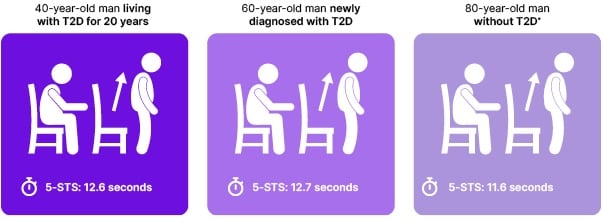BACKGROUND AND AIMS
Physical function decline is an increasingly recognised concern among individuals with long-term conditions such as Type 2 diabetes (T2D).1 This decline often coexists with obesity and is now observed at younger ages, reflecting the rising prevalence of early-onset T2D and its associated complications.2 These trends contribute to elevated risks of sarcopenia and frailty, with significant implications for long-term morbidity.3 Despite growing awareness, the relationship between the duration of T2D and physical function outcomes remains unexplored. Understanding the association is critical for identifying individuals at greatest risk and informing targeted interventions. The aim of this study was to evaluate the association between T2D duration and physical function outcomes, independent of chronological age.4
MATERIALS AND METHODS
The authors analysed data from individuals with T2D in the CODEC study, a cross-sectional, multisite, observational trial exploring chronotype and health outcomes in the UK in individuals with T2D.5 Physical function was assessed using the short performance physical battery (SPPB), 4-metre gait speed, five-repetition chair sit-to-stand (5-STS), 60-second chair sit-to-stand (STS-60), handgrip strength (sex-specific), and the Duke Activity Status Index (DASI). Associations between self-reported T2D duration and physical function outcomes were evaluated using linear regression models, adjusted for age, sex, and ethnicity.
RESULTS
A total of 1,204 participants were included (mean age: 65±12 years; age at diagnosis: 54±14 years; HbA1c: 53±15.2 mmol/mol [7±1.4%]; T2D duration: 11±11 years; BMI: 31±7 kg/m2). The cohort was predominantly White (84%), with 12% South Asian representation. Baseline physical function scores were an SPPB score of 11±3 points, a gait speed of 4.2±2 seconds, a 5-STS of 14±4 seconds, an STS-60 of 22±8 repetitions, a handgrip strength of 38±12 kg in men and 23±9 kg in women, and a DASI score of 43±24 points. Longer T2D duration was significantly associated with poorer physical function across all measures, independent of age, sex, and ethnicity. Specifically, each 10-year increase in T2D duration was associated with:
- a 0.3-point lower SPPB score (95% CI: –0.41–-0.11; p<0.001);
- a 0.2-second slower gait speed (95% CI: 0.06–0.30; p=0.003);
- a 0.6-second longer 5-STS time (95% CI: 0.12–1.01; p=0.013);
- 0.7 fewer repetitions in STS-60 (95% CI: –1.29–-0.02; p=0.043);
- a 1.02 kg lower handgrip strength in men (95% CI: –1.87–-0.16; p=0.020) and a 0.8 kg lower handgrip strength in women (95% CI: –1.64–0.08; p=0.074); and
- a 1.9-point lower DASI score (95% CI: –2.94–-0.77; p<0.001).
To contextualise, a 40-year-old man living with T2D for 20 years would be expected to have a 5-STS time of approximately 12.6 seconds (Figure 1). This indicates that, by midlife, he has already experienced a clinically significant decline in physical function.6 This estimate is comparable to that of a 60-year-old man with newly diagnosed T2D (12.7 seconds) and both closely resemble the normative value for an 80-year-old man without T2D (11.6 seconds; Figure 1).7

Figure 1: Five-repetition chair sit-to-stand test in association with Type 2 diabetes duration.
*Data presented as mean.7
5-STS: five-repetition sit-to-stand; T2D: Type 2 diabetes.
CONCLUSION
The authors’ findings illustrate the cumulative impact of T2D duration on physical function, independent of chronological age. This highlights the need for greater awareness among healthcare professionals and patients regarding the long-term functional consequences of T2D. Future research should focus on evaluating the effectiveness of pharmacological, nutritional, and exercise-based interventions in preserving physical function and improving long-term outcomes in this population.







